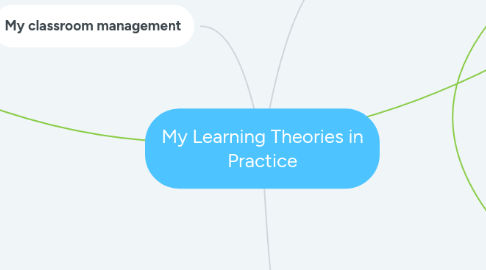
1. My classroom management
1.1. My classroom management style is more behavioralist than cognitive
1.1.1. I use reward stimulous when students do a good job
1.1.2. I create a contingency contract (Schunk, p 113) with students to alter behaviors that are less productive in the classroom
1.1.3. Preferred reward stimulus is variable-ratio positive reinforcement.
1.1.3.1. This option allows me to get the student excited about the new "outcome" if they create a more conducive learning environment in the classroom
1.2. Potential Improvements
1.2.1. Rewards are good tools to use, but for some students it just isn't enough. Because I do not always see the same students for more than just a few lessons, I tend not to "worry" about these behavior problems as much as I should, if my methods are not working (taking the easy way out)
1.2.2. More strict behavior methods should be tried, including the potential for other reinforcements, including negative ones which I hesitate to use.
2. Instructional delivery style
2.1. I attempt to influence a students attitude; if they come to class upset or bored, I attempt to match and then increase their energy level
2.2. When possible I have students "write" or otherwise use phsycial movement to connect a concept to an external phsycial response
2.3. I use TPR to express a concept (using verbal, phsycial and visual cues)
2.3.1. If a student is not responding to my physical or visual cues, I attempt something more tangible
2.4. Efforts to gain their attention early in the lesson include sharing personal experiences or events I've had, or asking about theirs
2.4.1. In my experience, when a student is more interested in the environment, or even in what I have to say about my life, they will continue this interest well into the lesson
2.5. Although my instructional style is more cognitive, this is also reflective of the behavioralist style preference; variable-ratio postitive reinforcement, which seems to meld with the cognitive focus of my instruction
2.6. I utilize student repport instead of punative measures to help keep student attention focused inside the classroom; with virtual learning outside distractions can be a huge challenge at times
2.7. Potential Improvements
2.7.1. My personal rapport with students can actually act as a distraction at times. While it is good to have rapport, sometimes it leads to more extraneous discussion and less focus on the lesson at hand.
3. Lesson plan construction
3.1. While I do not plan my own lessons, I do have the flexibility to augment or arrange/remove items depending on a student's learning capabilities. This is also influenced by my instructional style.
3.1.1. Often, if a student is doing well, I remove repetitive slides that may make them bored with the lesson; I may insert more challenging activities instead if there is time, or spend more time on another concept
3.2. I do not always follow the instructions for an individual slide if I know that a student will learn the materials better in another way
3.2.1. A slide may ask my student to write the spelling of a word, but I know that if the student verbalizes the spelling 2-3 times they have a better shot at remember it three slides later
3.3. Potential Improvements
3.3.1. Sometimes I spend more time on a concept that seems very important, only to realize that I have no time left for another, equally important concept. I could learn to guage this more and spend less time attempting to increase cognitive awareness and understanding (students repeatedly get the same information for several lessons)
